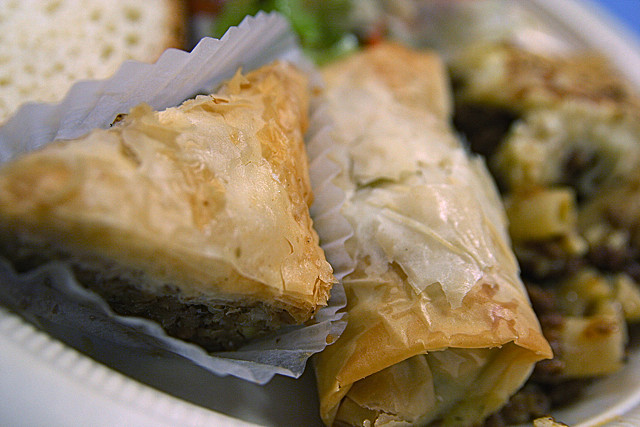There are people who travel to other countries and then seek out the foods they eat at home, which cheats them of the full experience in an exploration and exchange of cultures. Should any of these people find themselves in Greece, it is strongly recommended to discard the urge to eat the familiar and pursue the culinary delights of the country, from the simple to the complex.
Of course, there are many more than six dishes that visitors should try, a definite deluge of delectable delicacies, but for the sake of brevity, the following are a collection of traditional dishes embodying the nation’s tastes and sense of cooking composition.

The Meat Dishes
Gyros are found in practically every city in the world, but to have one in Greece makes a noticeable difference. First, many places tend to use actual pieces of meat on the spit, not the commonly found processed, ground and pre-formed meat used in other places. Traditionally, the meats are a mix of pork and lamb but nowadays beef and chicken are also served regularly. The meat is seasoned with salt, pepper, paprika, and perhaps another spice or two, then rotisserie grilled to a crispy golden-brown on the outside and juicy on the inside. The real way to go is to get the sandwich loaded with everything: onions, tomatoes, tzatziki (a thick yogurt sauce with a hint of garlic and cucumber), and french fries, which are the crucial ingredient missing in most other places.
Avgolemeno soup qualifies as a meat dish because it is a hearty meal of chicken and rice served in a seasoned broth, complemented by a frothy egg and lemon finish that is worked into the mixture yet remains an independent component of the dish. Typically, this recipe is only seasoned with salt and pepper. When done properly, one will be surprised at the intense flavor provided by the combination of these few, simple ingredients.
Stifado is essentially an onion stew that invites some meat or fish to the party. Pearl onions or small boiler onions are commonly used and are softened delicately in a rich tomato based stock seasoned with salt, wine, herbs, bay leaves and a dash of cinnamon. Meats or fish are then stewed to tender flakiness in this concoction either on the stove top or in an oven and it is generally served over oven-roasted potatoes. Alternatively, sometimes it is served over rice or orzo.

The Vegetarian Dishes
Choriatiki salata, known throughout the world as the Greek Salad, is one of life’s most elegant simple pleasures. Thick cuts of cold tomato and cucumber combined with sliced onion, black or green olives (maybe both with any luck), and slabs of heavenly feta cheese, all graced with a healthy dose of olive oil, salt and pepper. Occasionally, other items like carrots or yellow banana peppers find their way into the salad, but the staple ingredients alone perform wonders for the palate.
Mousaka, while commonly made with ground beef, can often be found in vegetarian form, usually with eggplant as the star of the show. Sautéed eggplant, onions, garlic, mushrooms and zucchini are mixed into a tomato sauce then layered over fried or roasted potatoes at the bottom of a roasting or casserole dish. The layers are doubled, then covered with a creamy béchamel sauce and topped with cheese. This dish is baked to a steamy, fluffy state and satisfies to the core.
Spanakopita is another fairly common ingredient dish not found in other places on the globe. Small chunks of feta cheese are mixed with chopped, sautéed spinach, onions, fennel and mint, achieving a unique flavor characteristic. The mixture is then stuffed into a flaky filo dough and glazed with an egg wash before being baked to pastry paradise perfection.
While there are a myriad of spreads, sides and entrees that will astound the taste buds, these dishes are a small collection of epitomizing Greek ingredients and fare. Most of these items can be found in any restaurant, and gyros and spanakopita are available from many stand-alone shops, carts, bakeries and kiosks.
As they say in Greece, Kali orexi!


